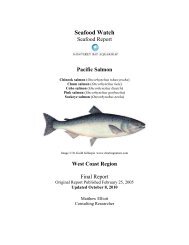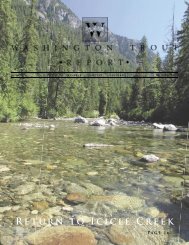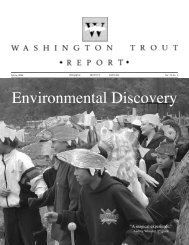Whidbey Island Near Shore Research Project
Washington Trout Report - Wild Fish Conservancy
Washington Trout Report - Wild Fish Conservancy
- No tags were found...
You also want an ePaper? Increase the reach of your titles
YUMPU automatically turns print PDFs into web optimized ePapers that Google loves.
they are critical to not only salmon and waterfowl but to<br />
crab and shellfish, forage fish and sea-run cutthroat trout.<br />
The two species of Puget Sound salmon currently listed<br />
under the ESA—Chinook and summer chum—have been<br />
identified as the most dependent upon estuaries. The loss<br />
of tidal wetlands have, similarly, been cited as the principal<br />
reason for the decline of waterfowl in Puget Sound.<br />
When estuaries and nearshore marine areas are healthy,<br />
they support far more ducks and salmon than grain plots<br />
or hatcheries can. It is hard to imagine a situation where<br />
improving the intertidal environment will not benefit both<br />
ducks and salmon.<br />
That appears to be what’s happened on the<br />
Dosewallips. Although Washington Trout’s restoration<br />
project was designed primarily to improve salmon habitat,<br />
it has made waterfowl forage more accessible and has<br />
provided a larger and more protected resting and roosting<br />
area. Birds can fly, of course, and ducks will move to<br />
cultivated foods and alternate shelter when necessary. But<br />
my experience suggests that they prefer to stay in one<br />
place when they can. It shouldn’t come as a surprise that<br />
the place the Dosewallips ducks chose this winter is a<br />
larger and better functioning estuary. Finally, the project’s<br />
potential to increase chum and pink salmon will eventually<br />
provide increased late season forage for waterfowl and<br />
nutrients for intertidal vegetation.<br />
As for the duck hunting, I eventually had my best<br />
season ever—although I had to adapt, as Ben Welton<br />
predicted. Widgeon, which were previously my most<br />
common species, dropped off considerably. This was partly<br />
the result of lower numbers, but the birds that were here<br />
tended to stay in the estuary. On the other hand, I did better<br />
than usual on mallards and pintail. Instead of flying north<br />
on incoming tides, though, they remained at the Dosey<br />
through the high turn. But I eventually noticed that little<br />
flocks flew north midway through the ebb, when the upper<br />
reaches of the intertidal zone drained. Not only did they<br />
fly at different times, they often flew over the marsh rather<br />
than along the canal. As a result, most of my birds this year<br />
were taken over flooded saltgrass and pickleweed, rather<br />
than open water.<br />
That was fine with me, but Lily didn’t like it<br />
particularly. She prefers to swim for her ducks. @<br />
Wish List<br />
1. Serviceable, good quality copier with paper feeder.<br />
2. Late model lazer printer.<br />
2. Small business network and server.<br />
<strong>Project</strong> Updates<br />
Washington Trout Field Staff<br />
Cherry Creek Floodplain Restoration<br />
In lower Cherry Creek, a tributary of the Snoqualmie<br />
River, an aging agricultural drainage system, including a<br />
pump house and over 10,000 meters of ditched channels,<br />
is currently compromising salmon habitat and natural<br />
processes promoting salmon production. In 1998 the<br />
“macerating” pump facility, operated during peak salmon<br />
smolt outmigrations, was shown to be a direct cause of<br />
mortality to thousands of juvenile salmonids, including<br />
ESA-listed chinook. Water quality is reduced in lower<br />
Cherry Creek; the ditched and straightened mainstem<br />
channel and simplified and disconnected floodplain<br />
channels lack habitat complexity and diversity.<br />
A new hydrostalic pump system on Cherry Creek will allow fish passage<br />
over a wider range of flows.<br />
In 2002 and 2003, Washington Trout conducted<br />
a feasibility study to assess whether and how effectively<br />
salmon rearing and spawning habitat could be improved<br />
and natural processes restored in Cherry Valley without<br />
impacting existing agricultural land use. WT worked<br />
closely with King County Drainage District 7, the<br />
Snohomish Conservation District, Washington Department<br />
of Fish and Wildlife, NOAA Fisheries and affected<br />
landowners to develop a restoration plan with a high<br />
likelihood of success.<br />
In Summer 2004 Washington Trout was awarded<br />
a $75,000 grant from the National Fish and Wildlife<br />
Foundation and the King County Community Salmon<br />
Fund to support the Cherry Creek Floodplain Restoration<br />
<strong>Project</strong>, the culmination of a collaborative planning effort<br />
by WT and its partners. The major habitat restoration<br />
objectives of the project are (1) to upgrade the pump<br />
facility with a more fish-friendly system facilitating<br />
22






